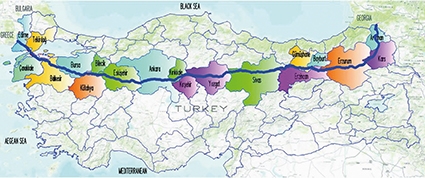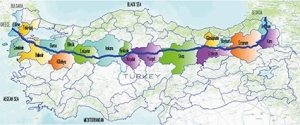Launch of the TANAP Pipeline: Implications for the South Caucasus
Op-ed
On June 12, the official launch ceremony of the TANAP pipeline was held in Turkey. TANAP is the key component of the Southern Gas Corridor, which should bring Azerbaijani gas to Europe, circumventing Russia. At the initial stage, annually 6 billion cubic meters of gas will be supplied to Turkey and another 10 billion to South Eastern Europe, mainly Italy. In later stages, the volume may be increased due to additional gas from the Azerbaijani Shah Deniz field, or potentially involving other gas sources such as Iraq and Turkmenistan.
If the Southern Gas corridor is to be filled only by Azerbaijani gas, it will not have serious implications for European energy security. The maximum capacity of Azerbaijan export will not exceed 20 billion cubic meters annually. Given the fact that in 2017, Russian Gazprom exported approximately 194 billion cubic meters of gas to Europe (including Turkey), even 20 billion could not significantly decrease the Europe dependence on Russian gas. Moreover, the main consumers of Russian gas are Western European states, with Germany importing some 53.5 billion cubic meters in 2017. Thus, if Europe wants to make TANAP a real tool of energy independence from Russia, it also needs to involve other sources. However, the prospects for a Turkmenistan-Azerbaijan-Trans Caspian pipeline are dim due to the objections from Russia and Iran. Given the instability in Iraq, even in the midterm perspective it would be difficult to bring Iraqi gas into TANAP and then further into Europe. Thus, the TANAP pipeline and southern gas project would have a limited impact on European energy security and geopolitics.
However, the situation is not the same for the South Caucasus. The region is going through significant political transformations. The “Velvet Revolution” in Armenia, which resulted in the resignation of longtime leader Serzh Sargsyan and the significant weakening of the former ruling Republican Party position, alongside the resignation of Georgian Prime Minister Giorgi Kvirikashvili, are evidence of domestic instability and popular resentment against the stagnation in economy, widespread poverty and lack of good governance. The mass protests in Yerevan and Tbilisi, organized with large scale use of digital technologies and social media, have proved the growing influence of popular movements. The situation in Azerbaijan remains stable as President Aliyev enters his fourth seven-year presidential term. However, the continuing pressure on the opposition is a sign of concern among Azerbaijani leadership.
The South Caucasus remains a hot spot of the competing interests of Russia, the West, Turkey and Iran. Russia makes efforts to solidify its control over the region, viewing it as a part of the Russian buffer zone which should hinder the Western encroachment into Russia. The West seeks to contain Russia in the Post-Soviet space, and the South Caucasus is part of this battle. The main ally of the West is Georgia, however, despite being a CSTO and EAEU member, Armenia also keeps partner relations with the US, NATO and the EU, and Azerbaijan seeks to keep a balance, rejecting both the Association Agreement with the EU and membership of the Eurasian Economic Union. Turkish policy in the region is based on its strategic relationship with Azerbaijan and efforts to deepen Georgia’s involvement in the trilateral Azerbaijan – Georgia – Turkey alliance. However, Turkey is keen not to bother Russia too much. Iran’s main concern is not to allow the South Caucasus to be used as a launchpad against it by the US and Israel. Tehran is willing to accept Russian dominance over the region at least up to the moment when it may fundamentally normalize its relations with the West.
In this context, the launch of TANAP strengthens the geopolitical and geo-economic potential of Azerbaijan. It emphasizes the leading role of the country in the regional energy geopolitics. The additional project linking Azerbaijan with Georgia and Turkey fosters the trilateral cooperation. Meanwhile, TANAP circumvents Armenia and bodes well for Azerbaijani efforts to isolate Yerevan. Azerbaijan successfully portraits itself as an energy and transportation hub for both the East - West and North – South corridors. The launch of Baku – Tbilisi – Kars railway and the railroad connecting Azerbaijan with Iran (Astara - Astara) are other key components of Azerbaijan strategy to be transformed into a regional hub.
The TANAP pipeline is an asset for Georgia too. It supports the Georgian narrative of a stable transit state which has the necessary capacities to bring Caspian energy resources to Europe. The Azerbaijan – Georgia – Turkey deepening relations are significant leverage for Georgia in its interactions with Russia. Meanwhile, growing Azerbaijani and Turkish influence in Georgia could be a source of concern for authorities given the existence of a large ethnic Azerbaijani minority. In this context, Georgia should be interested in fostering relations with Armenia as a potential balancing act against Azerbaijan and Turkey.
The launch of the TANAP pipeline stresses the isolation of Armenia from the regional transit projects. However, Yerevan has its own trump cards. The “Velvet Revolution” has significantly increased the positive image of Armenia in the West. The improvements in the business environment may gradually bring additional FDI into the country. Meanwhile, Yerevan should pay more attention to any transit projects potentially involving Armenia. In this context, the launch of “Persian Gulf – Black Sea” multimodal transportation corridor connecting Iran with Europe via Armenia and Georgia serves both Armenian and Georgian interests. Armenia may break its infrastructure isolation, while Georgia can add a North – South route alongside the East – West corridor to its transit potential.
By Benyamin Poghosyan











